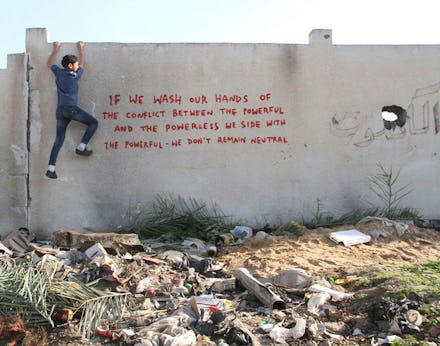Banksy Snuck into Gaza to Show You What the Mainstream Media Won't

Anonymous graffiti artist Banksy's latest work of art isn't tucked behind an urban rubbish bin or painted on the side of a skyscraper — it's on YouTube.
The artist, whose poignant, pointed street art has captivated fans and frustrated critics around the world, has released a darkly satirical video on his YouTube channel depicting the hottest new "traveler's paradise": the ruins of the Gaza Strip.
The piece, titled "Make This the Year YOU Discover a New Destination," juxtaposes the language and format of a low-budget tourist video with footage of the war-torn Gaza Strip and the suffering of Palestinians quarantined within it. Shot after entering the forbidden territory "via a network of illegal tunnels," Banksy welcomes you to Gaza in the same controversial fashion that has made his street artworks into icons.
"The locals like it so much they never leave!" The piece's cheerful tone and travel-brochure clichés belies depictions of the ruins of the Gaza Strip: crumbled buildings, guard towers manned by Israeli soldiers armed with heavy artillery, children playing amid the rubble of 18,000 destroyed homes.
Gaza was decimated in the summer of 2014 by Operation Protective Edge, an Israeli military operation with the stated aim of ending rocket attacks against Israel and destroying Gaza's tunnel system, a network of underground passageways that allowed the importation of artillery into the territory. The operation entailed 50 days of sustained bombardment of the Gaza Strip. At the peak of the fighting, more than 500,000 Palestinians were displaced; the United Nations estimates that at least 108,000 are still homeless. 2,205 Palestinians were killed in the operation, including at least 1,483 civilians.
More than six months since the operation ended, Gaza still looks like a war zone. International housing organizations estimate that the cost of rebuilding the thousands of razed homes and damaged infrastructure will reach $6 billion over 20 years. Even that time period is ambitious: Banksy notes in the video that concrete has not been allowed into Gaza since the ceasefire was announced.
The piece also features a sampling of the Palestinian reaction to one of the four new graffiti artworks debuted in the video.
"This cat tells the whole world that she is missing joy in her life," a man tells the videographer (presumably Banksy him/herself), describing an untitled work in which a spray-painted kitten interacts with debris on the street. "The cat found something to play with — what about our children? What about our children?"
The video ends with a sustained shot of Banksy's final, and most intensely political, work in the Gaza Strip. Scrawled in bright red paint on the ruins of another destroyed edifice, the piece tells the viewer, "If we wash our hands of the conflict between the powerful and the powerless, we side with the powerful – we don't remain neutral."
Afflict the comfortable, comfort the afflicted: The video is a brilliant combination of art and politics in a place devoid of beauty. Banksy's work has long highlighted social problems, but his work inside the Gaza Strip (an area largely cordoned off from Western media outlets) focuses his fan base's attention on international issues that are often too "hot" for artists.
Banksy's works have always dealt with political and social themes, but the so-called "third rail" has simultaneously incensed and delighted the artist's most fervent followers. The reaction to the latest works on Banksy's unofficial Facebook page has ranged from anger at the artist's political stance to kudos for touching on one of the most complicated human rights conflicts in the world.
It's important to note that some of Banksy's statements in the video aren't accurate, or are more complicated than the artist lays out. For example, the video alleges that concrete has not been allowed into the Gaza Strip since the end of Operation Protective Edge. While the United Nations has reported that the importation of construction materials has been severely hampered, Israel's embargo on most construction materials has been eased since 2012. According to the Israel Defense Forces, 181,000 tons of construction supplies legally entered Gaza in 2014.
If the artist's famous resistance to authority is any indication, the art world can expect more works from Banksy in conflict areas around the globe — with the occasional anti-consumerist rat along the way.